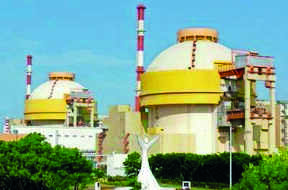NEW DELHI: A machine-building division of Russian atomic agency Rosatom, AEM-Technologies Izhora, has shipped a 187-tonne pressuriser for unit-5 of the Kudankulam nuclear power plant. The item was shipped to India on April 3 and will cover a distance of over 17,000 km to its destination in Tamil Nadu. The pressuriser is referred to as the primary circuit equipment of the VVER reactor and responsible for creating and maintaining pressure and coolant volume. It is used to limit pressure fluctuations in transient and emergency modes. When assembled, it is about 14 m long and 3.3 m in diameter. Its capacity is 79 cubic metres and wall thickness is 152 mm.
During a hydraulic test, the equipment passed a tightness test at high temperature and maximum admissible pressure of 24.7 MPa. The Kudankulam plant will include 6 power units with VVER-1000-type reactors with an installed capacity of 6000 MW. The first phase consisting of units No. 1 and No. 2 was already connected to the national electricity grid in 2013 and 2016, respectively. Currently, the construction on nuclear units 3, 4 and 5, 6, which are the second and third phases of the plant is going on.
NPCIL and Rosatom finalised the reactor design and engineering supervision arrangements for the construction of KNPP’s phase one in 1998, which cost Rs 140 billion ($2.47 bn). The total cost of the project for the six units is approximately Rs 1.11tn ($ 16.3bn). The Kudankulam plant has a production life of 60 years, which can be extended by another 20 years.
The first unit supplies power at a cheaper rate of about Rs 3.89 per unit. The plant’s home state Tamil Nadu is allocated 50% (925 MW) of the power generated, while neighbouring states share 35% of the residual power — 442MW for Karnataka, 266MW for Kerala and 67MW for Puducherry. The final 15% of the generated power is unallocated and will be added to a central pool.
During a hydraulic test, the equipment passed a tightness test at high temperature and maximum admissible pressure of 24.7 MPa. The Kudankulam plant will include 6 power units with VVER-1000-type reactors with an installed capacity of 6000 MW. The first phase consisting of units No. 1 and No. 2 was already connected to the national electricity grid in 2013 and 2016, respectively. Currently, the construction on nuclear units 3, 4 and 5, 6, which are the second and third phases of the plant is going on.
NPCIL and Rosatom finalised the reactor design and engineering supervision arrangements for the construction of KNPP’s phase one in 1998, which cost Rs 140 billion ($2.47 bn). The total cost of the project for the six units is approximately Rs 1.11tn ($ 16.3bn). The Kudankulam plant has a production life of 60 years, which can be extended by another 20 years.
The first unit supplies power at a cheaper rate of about Rs 3.89 per unit. The plant’s home state Tamil Nadu is allocated 50% (925 MW) of the power generated, while neighbouring states share 35% of the residual power — 442MW for Karnataka, 266MW for Kerala and 67MW for Puducherry. The final 15% of the generated power is unallocated and will be added to a central pool.



